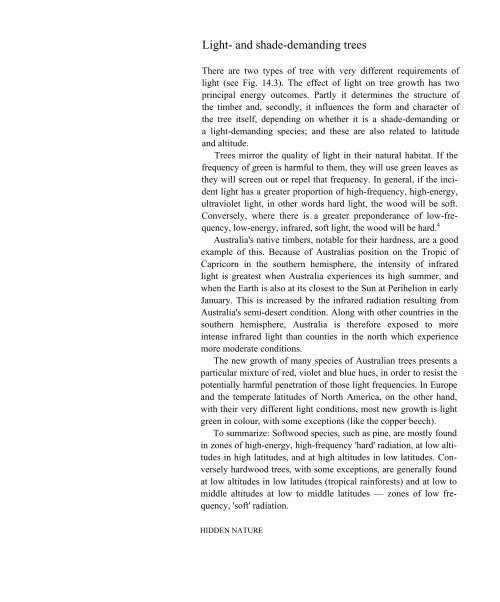levitational current - Free Energy
levitational current - Free Energy
levitational current - Free Energy
Create successful ePaper yourself
Turn your PDF publications into a flip-book with our unique Google optimized e-Paper software.
Light- and shade-demanding trees<br />
There are two types of tree with very different requirements of<br />
light (see Fig. 14.3). The effect of light on tree growth has two<br />
principal energy outcomes. Partly it determines the structure of<br />
the timber and, secondly, it influences the form and character of<br />
the tree itself, depending on whether it is a shade-demanding or<br />
a light-demanding species; and these are also related to latitude<br />
and altitude.<br />
Trees mirror the quality of light in their natural habitat. If the<br />
frequency of green is harmful to them, they will use green leaves as<br />
they will screen out or repel that frequency. In general, if the incident<br />
light has a greater proportion of high-frequency, high-energy,<br />
ultraviolet light, in other words hard light, the wood will be soft.<br />
Conversely, where there is a greater preponderance of low-frequency,<br />
low-energy, infrared, soft light, the wood will be hard. 4<br />
Australia's native timbers, notable for their hardness, are a good<br />
example of this. Because of Australias position on the Tropic of<br />
Capricorn in the southern hemisphere, the intensity of infrared<br />
light is greatest when Australia experiences its high summer, and<br />
when the Earth is also at its closest to the Sun at Perihelion in early<br />
January. This is increased by the infrared radiation resulting from<br />
Australia's semi-desert condition. Along with other countries in the<br />
southern hemisphere, Australia is therefore exposed to more<br />
intense infrared light than counties in the north which experience<br />
more moderate conditions.<br />
The new growth of many species of Australian trees presents a<br />
particular mixture of red, violet and blue hues, in order to resist the<br />
potentially harmful penetration of those light frequencies. In Europe<br />
and the temperate latitudes of North America, on the other hand,<br />
with their very different light conditions, most new growth is light<br />
green in colour, with some exceptions (like the copper beech).<br />
To summarize: Softwood species, such as pine, are mostly found<br />
in zones of high-energy, high-frequency 'hard' radiation, at low altitudes<br />
in high latitudes, and at high altitudes in low latitudes. Conversely<br />
hardwood trees, with some exceptions, are generally found<br />
at low altitudes in low latitudes (tropical rainforests) and at low to<br />
middle altitudes at low to middle latitudes — zones of low frequency,<br />
'soft' radiation.<br />
HIDDEN NATURE








![The Big Lie 9-11 and Government Complicity in Mass Murder [PDF]](https://img.yumpu.com/50957077/1/190x245/the-big-lie-9-11-and-government-complicity-in-mass-murder-pdf.jpg?quality=85)








